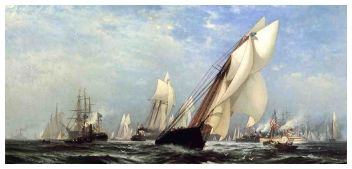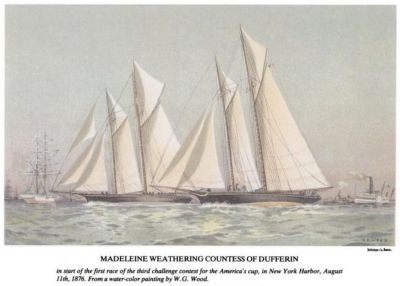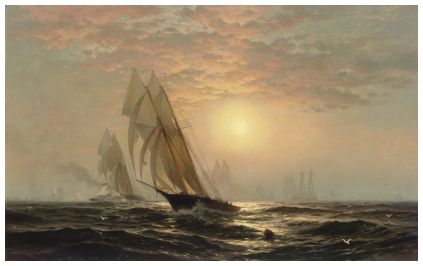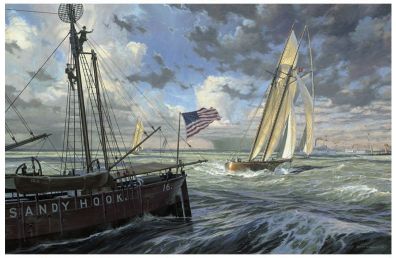Yves GARY Hits: 1653
Category: 1876 : CHALLENGE N°3
 THE MADELEINE DEFEAT THE CONTESS OF DUFFERIN BY TEN MINUTES AND FIFTY-NINE SECONDS
THE MADELEINE DEFEAT THE CONTESS OF DUFFERIN BY TEN MINUTES AND FIFTY-NINE SECONDSCopyright © The New York Times : Published: August 12, 1876
A bright cheery morning, the Long Island shore steeped in sunshine, and sunshine crowning the heights of Staten Island and flashing on the pleasant waters of the bay and on the white sails ...
... of the innumerable pleasure craft at their anchorage off Stapleton were some of the early features of the first race between the handsome Madeleine of the New-York Yacht Club and the challenging yacht the Countess of Dufferin, of Canada.
 . The wind about 10 o‘clock came light from the south with just a shade of the east in it, and the tide was running flood. The upper sky was clear, but on the western horizon there was a long range of clouds, not dark and sombre clouds, but others which had just lost their morning silver, and were new flushed and roseate. Out to seaward the colt Summer haze hung on the waters, and the low-lying Hook was lost in its influence, while the better-defined line of the Highlands was almost obscured. When the steam-boat W. E. Gladwich came down to Stapleton with the judges and other members of the Yacht Club on board, everything betokened active preparation. The silent, graceful courtesies which flags can signal and emphasize, end the harsh, discordant salutations which steam-boats know so-well how to give voice, were in bounteous progress. Nearly every yacht of the fleet, (and with a few conspicuous exceptions, such as the Idler, the Brenton Reef victor, and the Dreadnaught, they were all there.) were making ready to accompany the racers. Then the steam-boats began to arrive from the City with sightseers, the Rockaway boat and others which have set functions to perform dallied in their course, and were like persons with double duty bound, who know not how to begin or how to choose. And all this was about two yachts, which by a stranger could only be distinguished from the rest of the handsome pleasure craft by the fact that their hulls were pot-leaded, a matter in no way calculated to enhance their beauty. Regarding these two yachts as they lay at their anchorage or went through their preliminary manoeuvres, anybody would have deemed the result a foregone conclusion. The Madeleine, saucy, rakish and smart with her tall graceful masts, seemed fit to sail for a kingdom, at least in such halcyon weather, while her rival looked squat and heavy, and while she seemed fit for some rough knocks, never suggested the idea of speed. Yet there is much good quality in the graceless-looking craft, and if the race had the effect of proving the Madeleine the fast yacht which she has been always esteemed, it had no less the effect of greatly increasing the general respect for the sailing capacity of the stranger. Nor would it be too much to affirm that in the race today, if there is a heavy seaway and a stiff southeasterly breeze, she may give a still better account of herself.
. The wind about 10 o‘clock came light from the south with just a shade of the east in it, and the tide was running flood. The upper sky was clear, but on the western horizon there was a long range of clouds, not dark and sombre clouds, but others which had just lost their morning silver, and were new flushed and roseate. Out to seaward the colt Summer haze hung on the waters, and the low-lying Hook was lost in its influence, while the better-defined line of the Highlands was almost obscured. When the steam-boat W. E. Gladwich came down to Stapleton with the judges and other members of the Yacht Club on board, everything betokened active preparation. The silent, graceful courtesies which flags can signal and emphasize, end the harsh, discordant salutations which steam-boats know so-well how to give voice, were in bounteous progress. Nearly every yacht of the fleet, (and with a few conspicuous exceptions, such as the Idler, the Brenton Reef victor, and the Dreadnaught, they were all there.) were making ready to accompany the racers. Then the steam-boats began to arrive from the City with sightseers, the Rockaway boat and others which have set functions to perform dallied in their course, and were like persons with double duty bound, who know not how to begin or how to choose. And all this was about two yachts, which by a stranger could only be distinguished from the rest of the handsome pleasure craft by the fact that their hulls were pot-leaded, a matter in no way calculated to enhance their beauty. Regarding these two yachts as they lay at their anchorage or went through their preliminary manoeuvres, anybody would have deemed the result a foregone conclusion. The Madeleine, saucy, rakish and smart with her tall graceful masts, seemed fit to sail for a kingdom, at least in such halcyon weather, while her rival looked squat and heavy, and while she seemed fit for some rough knocks, never suggested the idea of speed. Yet there is much good quality in the graceless-looking craft, and if the race had the effect of proving the Madeleine the fast yacht which she has been always esteemed, it had no less the effect of greatly increasing the general respect for the sailing capacity of the stranger. Nor would it be too much to affirm that in the race today, if there is a heavy seaway and a stiff southeasterly breeze, she may give a still better account of herself.
 The trophy for which the race was sailed has been often referred to, and it needs no more explicit mention now than to state that it was the cup won by the America in England. The course was the usual one of the New-York Yacht Club, that is to say from the club-house, at Stapleton, round the South-west Spit buoy, round the Sandy Hook light-ship, and return, finishing off the West Bank. It was a little after 11.15 when the yachts were started on their way, and perhaps the start was one of the prettiest spectacles of the race. The wind had come round due south, the tide was still flowing, and it was necessary to beat up to and across the line. The manoeuvrjng was very expert on both sides, and after some obstructions caused by the attendant craft both vessels crossed on the port tack, the Madeleine at 11:16:31, and the Countess at 11:17:06. Each vessel carried a main club topsail, and the Countess had also a jib topsail set. All her sails were new with the exception of her jib, and she carried a great deal more mainsail than her before, her main boom having been lengthened seven feet.
The trophy for which the race was sailed has been often referred to, and it needs no more explicit mention now than to state that it was the cup won by the America in England. The course was the usual one of the New-York Yacht Club, that is to say from the club-house, at Stapleton, round the South-west Spit buoy, round the Sandy Hook light-ship, and return, finishing off the West Bank. It was a little after 11.15 when the yachts were started on their way, and perhaps the start was one of the prettiest spectacles of the race. The wind had come round due south, the tide was still flowing, and it was necessary to beat up to and across the line. The manoeuvrjng was very expert on both sides, and after some obstructions caused by the attendant craft both vessels crossed on the port tack, the Madeleine at 11:16:31, and the Countess at 11:17:06. Each vessel carried a main club topsail, and the Countess had also a jib topsail set. All her sails were new with the exception of her jib, and she carried a great deal more mainsail than her before, her main boom having been lengthened seven feet.
The first tack was a very brief one, but short as it was the speed of the Madeleine began to be manifest. She went buoyantly through the water, but the movements of the Countess were sluggish and she seemed to drag heavily astern. The Madeleine was the first to go about, and her rival followed suit almost immediately, working splendidly in stays. The Madeleine now ran up her staysail and was holding a splendid wind, but the Countess astern of her, pointed up closer. So they held their way over to the Long Island shore, when the Madeleine began to work up better to windward. She went at 11:29:30, having previously taken in her staysail, which served her but indifferently. When the Countess followed her example she was well behind in the double sense that she was both astern and to leeward.
 While the two yachts worked their way out through the Narrows, the scene was a really enchanting. The fleet of yachts were coming on in hot pursuit, and the glancing waters were beaten and churned by the throbbing, palpitating steam-boats. And all this nearer portion of the scene was radiant with sunlight, so that the Narrows, with its forts on either side, seemed a golden but guarded portal, through which the misty City behind was sending forth its white-winged argosies. There was, however, one thing lacking, some slight element of doubt which would unsettle ever so little the convictions of the spectators. But, possibly, in their cases the wish was rather to thought, and it would be treason to the handsome yacht which led the way to suppose that she could ever succumb to the uncouth stranger that yet sedulously pursued her. The Madeleine had gained and was gaining, and when at last they split tacks ere they had yet got outside the forts, the result being the gain of an entire tack, and that a winning one, to the representative of the New-York Yacht Club, previous expectations of victory grew into absolute certainty.
While the two yachts worked their way out through the Narrows, the scene was a really enchanting. The fleet of yachts were coming on in hot pursuit, and the glancing waters were beaten and churned by the throbbing, palpitating steam-boats. And all this nearer portion of the scene was radiant with sunlight, so that the Narrows, with its forts on either side, seemed a golden but guarded portal, through which the misty City behind was sending forth its white-winged argosies. There was, however, one thing lacking, some slight element of doubt which would unsettle ever so little the convictions of the spectators. But, possibly, in their cases the wish was rather to thought, and it would be treason to the handsome yacht which led the way to suppose that she could ever succumb to the uncouth stranger that yet sedulously pursued her. The Madeleine had gained and was gaining, and when at last they split tacks ere they had yet got outside the forts, the result being the gain of an entire tack, and that a winning one, to the representative of the New-York Yacht Club, previous expectations of victory grew into absolute certainty.
The Madeleine went about on the Long Island side at 11:04:21, and the Countess on the Staten Island side some two minutes later. When they crossed the Countess had to pass under the lee of her fleet rival, and was now about a sixth of a mile astern. After several other cross tacks, having no special significance, except that each was a gain to the Madeleine, they passed the forts, when they began to pursue different courses. The Madeleine, with admirable judgment, made a long reach into Raritan Bay by which she avoided the tide which was still flowing. Even had it turned she would have still benefited, for the ebb is soonest felt over in this quarter, and so would have helped her. The Countess, on the other hand, held toward Dix’s and Hoffman’s Islands, where she experimented the full force of the tide. She, too, at length, went about and followed the Madeleine, but she lost distance by the lateness of her determination.  So well did the bay agree with the Madeleine that she tacked into it a second time, and when she next went about set off on a long reach to the South-west Spit buoy (No. 10.) She was now a full mile ahead, and coming down by the Coney Island Beach was sailing with magnificent speed. Before making a corresponding tack, the Countess pointed well up to wind, and then going about started in pursuit of the Madeleine. The stretch across the bay was made without any perceptible change in the distance between them, and the Madeleine at 1:10 tacked to weather the buoy. This she accomplished at 1:19:19, amid the noisy salutations of the steamers that had gathered round. The Countess followed at 1:26:32, or more than seven minutes behind. The conditions of the race provided that the yachts were to go southward of buoy No. 8½, and to accomplish this more tacking was necessary. The Madeleine taking in her foretopsail, which she soon after reset, passed to the south of the buoy at 1:24:50, the Countess following at 1:32. A few minutes later the Countess took in her jib topsail, which, however, she afterward sent up again. In the sail out to the Sandy-Hook light-Ship the Countess made the best sailing which she had done during the day. She made one tack to the southward at 1:54, the Madeleine following at 1:57, and both tacking again at 2:10. At 2:41 the foretopsail of the Madeleine came down with marvelous rapidity, and with as admirable expedition a club topsail was run up in its place. Indeed, all through the Madeleine's sails were superbly handed- Nevertheless, in spite of her best exertions, the Countess gained some two minutes on her, and when they turned the light-ship, their time was:
So well did the bay agree with the Madeleine that she tacked into it a second time, and when she next went about set off on a long reach to the South-west Spit buoy (No. 10.) She was now a full mile ahead, and coming down by the Coney Island Beach was sailing with magnificent speed. Before making a corresponding tack, the Countess pointed well up to wind, and then going about started in pursuit of the Madeleine. The stretch across the bay was made without any perceptible change in the distance between them, and the Madeleine at 1:10 tacked to weather the buoy. This she accomplished at 1:19:19, amid the noisy salutations of the steamers that had gathered round. The Countess followed at 1:26:32, or more than seven minutes behind. The conditions of the race provided that the yachts were to go southward of buoy No. 8½, and to accomplish this more tacking was necessary. The Madeleine taking in her foretopsail, which she soon after reset, passed to the south of the buoy at 1:24:50, the Countess following at 1:32. A few minutes later the Countess took in her jib topsail, which, however, she afterward sent up again. In the sail out to the Sandy-Hook light-Ship the Countess made the best sailing which she had done during the day. She made one tack to the southward at 1:54, the Madeleine following at 1:57, and both tacking again at 2:10. At 2:41 the foretopsail of the Madeleine came down with marvelous rapidity, and with as admirable expedition a club topsail was run up in its place. Indeed, all through the Madeleine's sails were superbly handed- Nevertheless, in spite of her best exertions, the Countess gained some two minutes on her, and when they turned the light-ship, their time was:
 All the steamboats were gathered at the light-ship to give them a salute as they rounded, and more discordant courtesies were could not well be. As the Madeleine went round the Light-ship the admirable way in which her sails were handled was again manifest. Every sail that would no longer draw was down in an instant, and as rapidly all her balloon sails were run up. Her balloon staysail and balloon jib were filled and she was scudding before a free wind for home. Not so with her antagonist. Her sails were badly managed, and she lost all the time which she had previously gained by hard sailing. It was supposed that running tree she would have a chance of catching the Madeleine, but the notion was a mistaken one. At every buoy she was further behind and the hope she had raised in the stretch for the light-ship was baffled. The Madeleine passed buoy No.5½ at 3:45:37, and the Countess at 3:53:10. A fore club topsail did not help to better the conditions of the latter in her run for the South-west Spit, and when they finished off the West Bank the Madeleine's time was 4:41:26, and the Countess’ 4:51:59.
All the steamboats were gathered at the light-ship to give them a salute as they rounded, and more discordant courtesies were could not well be. As the Madeleine went round the Light-ship the admirable way in which her sails were handled was again manifest. Every sail that would no longer draw was down in an instant, and as rapidly all her balloon sails were run up. Her balloon staysail and balloon jib were filled and she was scudding before a free wind for home. Not so with her antagonist. Her sails were badly managed, and she lost all the time which she had previously gained by hard sailing. It was supposed that running tree she would have a chance of catching the Madeleine, but the notion was a mistaken one. At every buoy she was further behind and the hope she had raised in the stretch for the light-ship was baffled. The Madeleine passed buoy No.5½ at 3:45:37, and the Countess at 3:53:10. A fore club topsail did not help to better the conditions of the latter in her run for the South-west Spit, and when they finished off the West Bank the Madeleine's time was 4:41:26, and the Countess’ 4:51:59.
The actual and corrected time of both yachts is as follows:

The corrected time by which the Madeleine beats the Countess, receiving her allowance for measurement, is 10m. 59s. When the race finished there was a perfect fleet of yachts on the waters of the bay, and the scene was as inspiriting as in the morning. The courtesies to both yachts were on the most liberal scale and were extended alike vanquished and to victor. Everybody thinks better of the Canadian yacht, beaten though she be, and a good many people hold that under certain conditions of wind and seaway a victory for the Madeleine is not at all so assured to-day as it was yesterday. It is a notable fact that none of the non-racing yachts showed any capacity to beat either of the competitors, although is also fair to assume that they did not do their best. The America showed, however, with some prominence.
The race outside of Sandy Hook takes place to-day.
